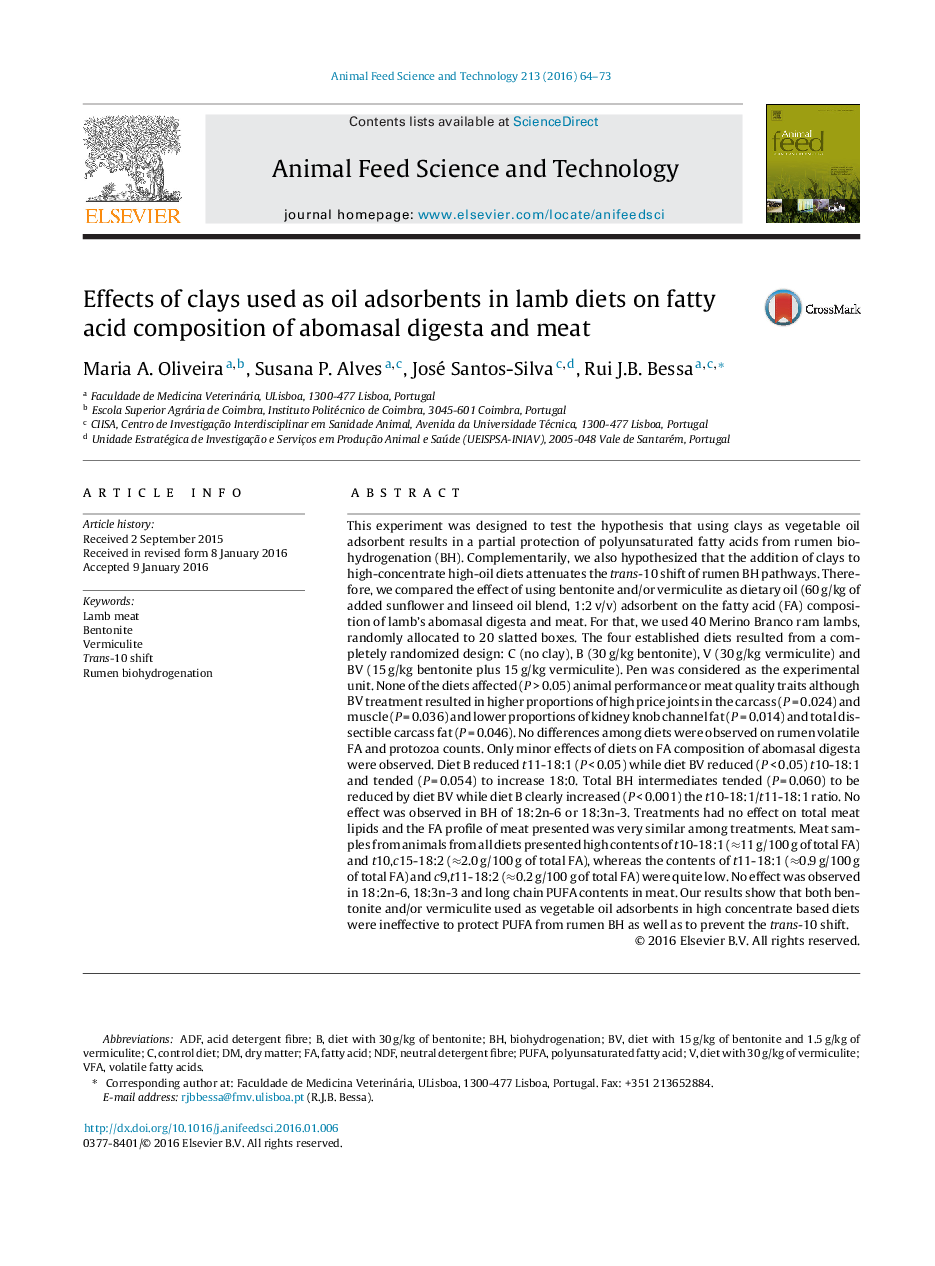| کد مقاله | کد نشریه | سال انتشار | مقاله انگلیسی | نسخه تمام متن |
|---|---|---|---|---|
| 2419350 | 1552372 | 2016 | 10 صفحه PDF | دانلود رایگان |
• Clays (bentonite and vermiculite) were used as oil adsorbents in lamb́s diets.
• Clays did not affect lamb growth or meat quality traits.
• Clays did not protect unsaturated fatty acids from rumen biohydrogenation.
• Clays did not prevent trans-10 18:1 accumulation in abomasal digesta and meat.
This experiment was designed to test the hypothesis that using clays as vegetable oil adsorbent results in a partial protection of polyunsaturated fatty acids from rumen biohydrogenation (BH). Complementarily, we also hypothesized that the addition of clays to high-concentrate high-oil diets attenuates the trans-10 shift of rumen BH pathways. Therefore, we compared the effect of using bentonite and/or vermiculite as dietary oil (60 g/kg of added sunflower and linseed oil blend, 1:2 v/v) adsorbent on the fatty acid (FA) composition of lamb’s abomasal digesta and meat. For that, we used 40 Merino Branco ram lambs, randomly allocated to 20 slatted boxes. The four established diets resulted from a completely randomized design: C (no clay), B (30 g/kg bentonite), V (30 g/kg vermiculite) and BV (15 g/kg bentonite plus 15 g/kg vermiculite). Pen was considered as the experimental unit. None of the diets affected (P > 0.05) animal performance or meat quality traits although BV treatment resulted in higher proportions of high price joints in the carcass (P = 0.024) and muscle (P = 0.036) and lower proportions of kidney knob channel fat (P = 0.014) and total dissectible carcass fat (P = 0.046). No differences among diets were observed on rumen volatile FA and protozoa counts. Only minor effects of diets on FA composition of abomasal digesta were observed. Diet B reduced t11-18:1 (P < 0.05) while diet BV reduced (P < 0.05) t10-18:1 and tended (P = 0.054) to increase 18:0. Total BH intermediates tended (P = 0.060) to be reduced by diet BV while diet B clearly increased (P < 0.001) the t10-18:1/t11-18:1 ratio. No effect was observed in BH of 18:2n-6 or 18:3n-3. Treatments had no effect on total meat lipids and the FA profile of meat presented was very similar among treatments. Meat samples from animals from all diets presented high contents of t10-18:1 (≈11 g/100 g of total FA) and t10,c15-18:2 (≈2.0 g/100 g of total FA), whereas the contents of t11-18:1 (≈0.9 g/100 g of total FA) and c9,t11-18:2 (≈0.2 g/100 g of total FA) were quite low. No effect was observed in 18:2n-6, 18:3n-3 and long chain PUFA contents in meat. Our results show that both bentonite and/or vermiculite used as vegetable oil adsorbents in high concentrate based diets were ineffective to protect PUFA from rumen BH as well as to prevent the trans-10 shift.
Journal: Animal Feed Science and Technology - Volume 213, March 2016, Pages 64–73
